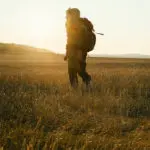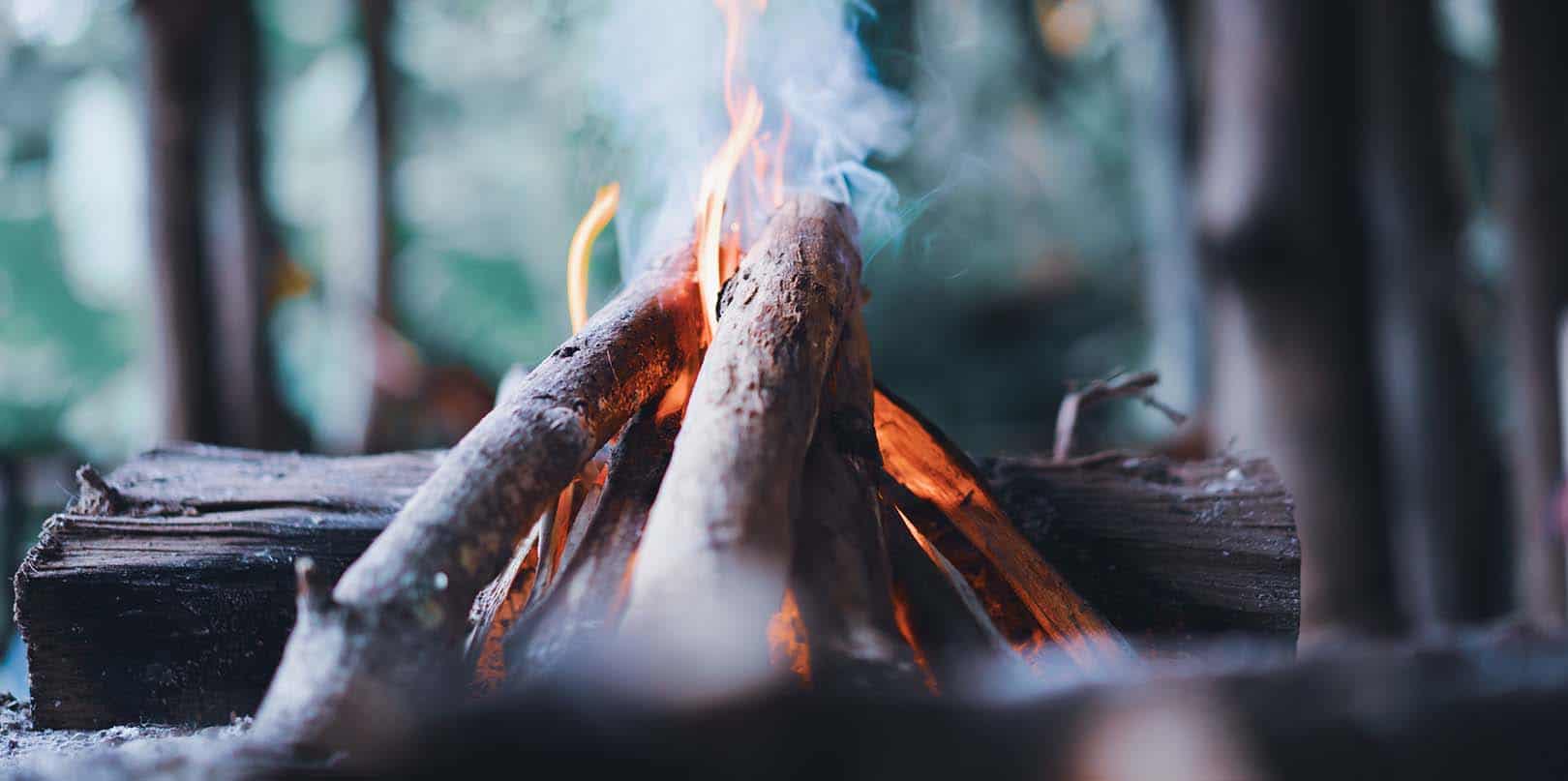Humans have always had a primal link between us and fire. Back in our caveman days, a fire was essential for providing us with warmth, protecting us from animals, lighting up the dark, surviving in the wild, and also a place to cook our food.
Nowadays, fire isn’t as essential to our existence, but there’s still something magnetic about it that attracts us to the flames. After all, there’s nothing better than cuddling up with a loved one in front of an open fire or sharing stories around the burning embers on the campsite.
If you are a fan of camping or like to keep your survival skills on point at all times, knowing how to make and light a fire is key. You should know all the steps for starting those flames, what to add to keep the branches burning and how to easily and safely extinguish the flame afterward.
How To Start A Fire In The Wild?
Here is our guide on everything you need to know about how to make a fire in the wild:
Creating the Fire Bed
Whenever you want to start building a fire, the first thing that should ever come to your mind is safety. Wildfires are rampant across the USA because people don’t know how to start a fire properly when camping. Many campsites now have designated areas where you can build a fire pit. If your campsite doesn’t, or you’re camping out in the wild, you have to make your own fire.
The first thing you should do is select a site for your fire bed. This needs to happen before you gather any material or kindling to get the fire burning. You should begin to form the basis of your fire on bare dirt. Never try to start a fire on the grass, especially dead grass, which is extremely flammable and spreads quickly.
If you find yourself lacking an area with bare dirt, don’t worry. You can make it yourself instead. Dig and rake away plant materials and grass to reveal the dirt and form the base of the fire bed.
Make sure you are paying particular attention to really getting rid of and taking care to clear away all dry grass and plant materials. Things like tree branches and bark are also flammable, so these need to be kept away from the fire unless you are using them for kindling too.
Once the dirt is clear, you can begin to make the structure that will become your fire bed. Gather up some dirt and then form it into a platform around 3 to 4 inches in thickness.
Gather your Materials and Tinder Kindling
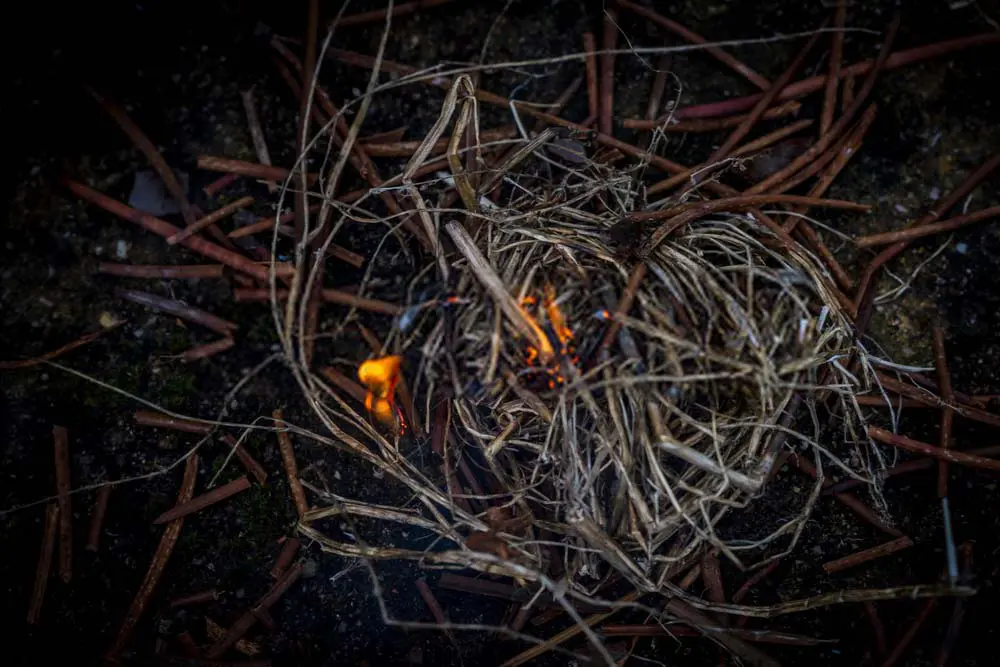
To get the best results when starting your fire, you need three different types of materials. These are what make up the basics of a roaring fire. Fuelwood from trees like logs and branches is the first thing you will need. Then look for tinder kindling to have the three essentials to form the fire.
Tinder
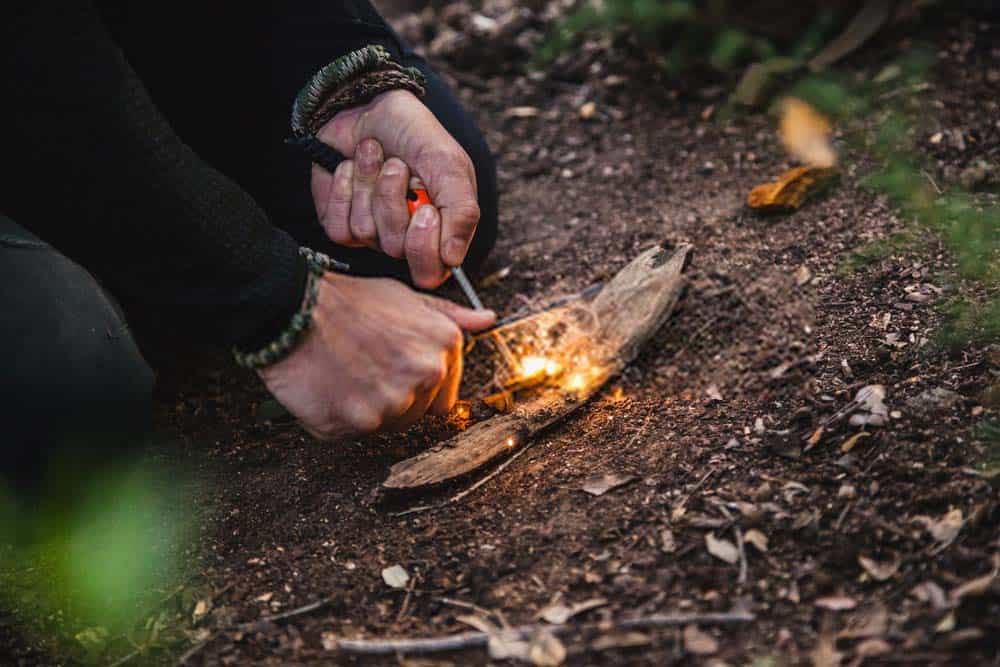
No, it’s not a popular dating app! Tinder is actually the very thing you will need to start a good fire. Please search for the right tinder, and when you add it to your fire, the flames will easily catch, and the material will burn faster as well. Tinder material has to be dry. So dry back, dry leaves, dry branches, dry wood shavings, and even dry grass makes excellent tinder.
If camping and survival skills are something you are already well versed in, having your own tinder on hand, like char cloth or dryer lint, is the pro way to go. Having dry tinder on hand can be essential when it’s wet outdoors. Wet tinder won’t catch fire easily or even at all.
Kindling
Tinder works so well to start a fire because it has a fast burn time. Because of this, you need a material like kindling that will keep the flames alight. Once your tinder is lit, many people mistake adding big logs straight onto the structure. This is a huge no-no because this will smother any small flame you have there. Instead, use kindling.
Kindling is normally made up of branches and twigs. You want to search for pieces of wood from trees roughly the same width as a pencil. Kindling also needs to be dry to burn.
Wood
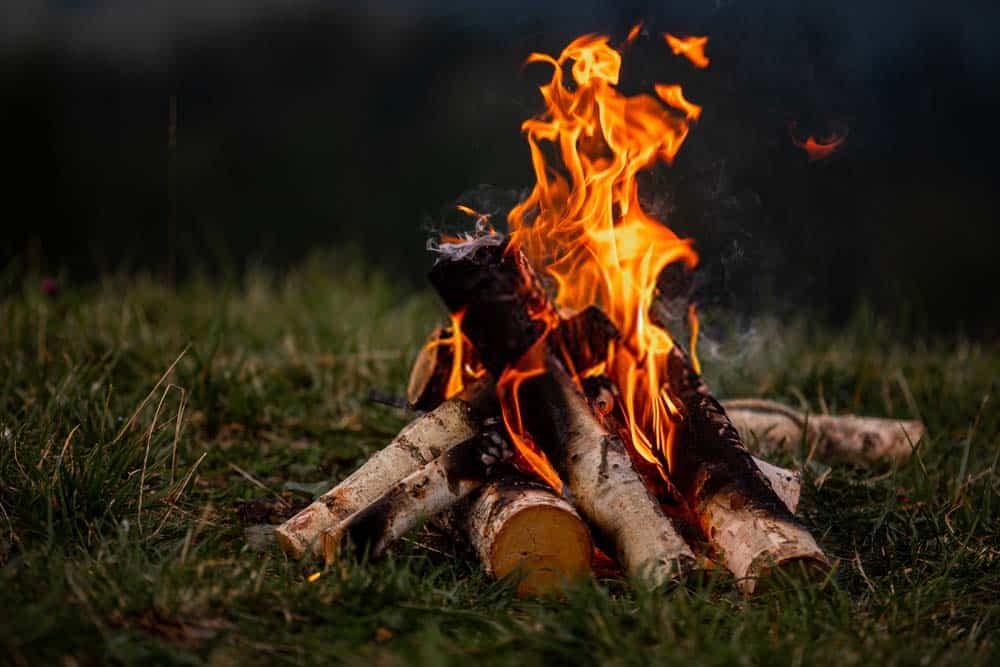
Once you have used your kindling and tinder, it’s time to keep the flame on a steady burn. The fire’s heat will come from the wood you use as fuel. Many people believe they need huge logs to keep the fire going. This isn’t the case at all. If you have started the fire correctly with kindling and tinder, you won’t need large logs.
Adding logs to your fire structure that are too large means the flame will take too long to catch and produce heat. Instead, you want logs around the size of your forearm or wrist.
A Few Tips for Collecting Kindling and Wood
You can easily collect everything you need to add to your fire if you know what to look for. Wood and logs that can easily be snapped are the ones to watch out for. This means the kindling is dry, and it will burn much better in the fire bed. Adding wood or kindling that bends or is wet will produce a lot of smoke, won’t burn well, and won’t give off any heat.
Another great tip is to double up on the amount of kindling, wood, and tinder you think you might need. Though your load will be lighter if you only get a few, you’ll make repeat trips because you get through the materials to start a fire so fast.
Where to Find Fire Starting Materials?
Depending on where you are building a fire will determine where you can collect your materials from. Here we will look at the two options for collecting firewood when wanting to start a fire.
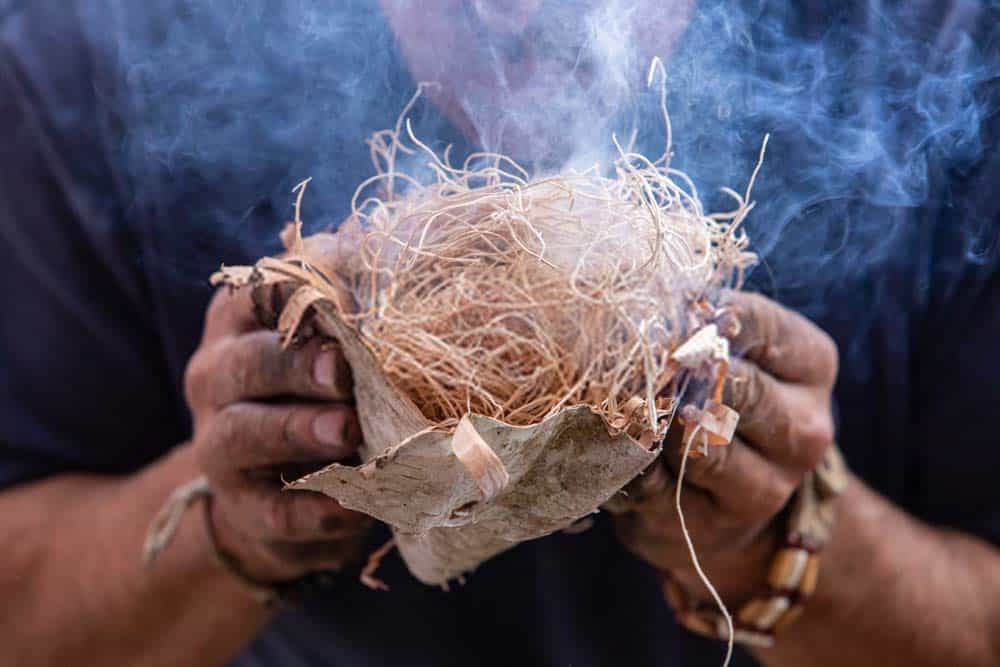
Campgrounds
If you are camping on a campground or site, there are certain rules you should follow when collecting wood. You should only use wood that has been locally sourced. Many stores in the area will usually carry packs for purchase. The campsite hosts may even offer kindling and firewood for your site fee.
The most important rule here is that you don’t bring your own stash of firewood if the campsite you visit is over 50 miles away. Some campsites will put an out-and-out ban on bringing your own firewood even if you are closer than the 50-mile limit. This helps them in their plight against pesky insects. You always call ahead and check the rules or speak with a park ranger for more advice and information.
Forest Foraging
If you are opting for a stay away from the campsite, then you will need to go foraging for your supplies. In this case, you should only pick up downed wood nearby. You should never cut at a live tree or break off any branches from standing trees, even if you think they are dead. This protects the local wildlife that needs those resources for nest building.
Another tip for foraging fire supplies is that you should only pick out pieces thinner than your wrist. Thicker pieces of wood never burn completely, resulting in blackened and unsightly scraps left behind in picturesque forest areas.
How to Best Lay a Fire
Now that you have got all of your materials, it’s time to put them together in the next step of how you start a fire. There are several different techniques on how you can lay a fire. Here we will look at the three most common I use when starting a fire.
Lean To Fire
- To start a fire with this structure, you must find a longer piece of kindling. This should be stuck into the ground at a 30-degree angle. Point the end of the stick in the direction the wind is blowing.
- Bundle your tinder together and place that underneath your supporting stick.
- You’ve now created a tinder nest. Gather some smaller pieces of kindling and start stacking them around the nest.
- You should also lay some of the small pieces of kindling against the stick that is in the ground. Now start layering bigger pieces of your kindling against the support stick.
- Now you can start your fire. Light the tinder using a lighter or a match, and watch as it begins to burn.
The Teepee Fire
- Once again, bundle your tinder together and place this in the middle of where you have a suitable fire bed.
- Above the bundle, craft a teepee out of your kindling. You should leave an opening in the teepee structure that faces the wind. This helps the fire breathe and get the air it needs while also helping the flames blow onto the kindling.
- Carry on adding the kindling and then work towards more pencil-sized twigs.
- With your wood and logs, build a larger teepee around the one you’ve already made from kindling.
- Put a match under the tinder bundle. The teepee structure helps to direct the flame upwards, so you should start to see the fire creeping up the kindling and onto the larger pieces of wood.
- This is a really effective way to start a fire but note that the teepee will collapse, and this is fine. At this point, you can keep adding logs for fuel.
The Log Cabin Fire
- To start a fire with a log cabin fire lay, you need to start by creating a teepee again.
- If you’ve ever played the game Lincoln Logs, this is basically what you will be doing to start a fire but burn them at the end (which isn’t part of the game).
- Get your large pieces of wood and place them on two opposite sides of your teepee structure.
- Then go to your small pieces of firewood and lay them across the larger ones you have just put down. They should be parallel to the other sides of the structure.
- Keep repeating this process and start to lay the shorter and smaller pieces. Eventually, it forms a pyramid or logs cabin shape.
- Use your lighter to start the fire.
Starting Your Fire
You can light your fire any way you want using flint, a lighter, or a match. You may also want to use a fire starter that can help you easily ignite the tinder so it catches the flame. After you have got your tinder lit, blow gently onto the base of the fire to give it the oxygen it needs to burn. This helps to improve the intensity of the flame as well as spreading the fire to the rest of the wood.
As your fire continues to burn, it’s important to move any embers into the center of the structure. This helps them to burn completely. Ideally, you want to reduce anything you are burning into white ash.
How to Put Out a Fire In The Wild
Now you know how to build and start a fire, you also need to know how to put it out. Being able to extinguish a fire properly is really important for safety reasons. Here are the guidelines to ensure that adding water to your fire will kill it for good.
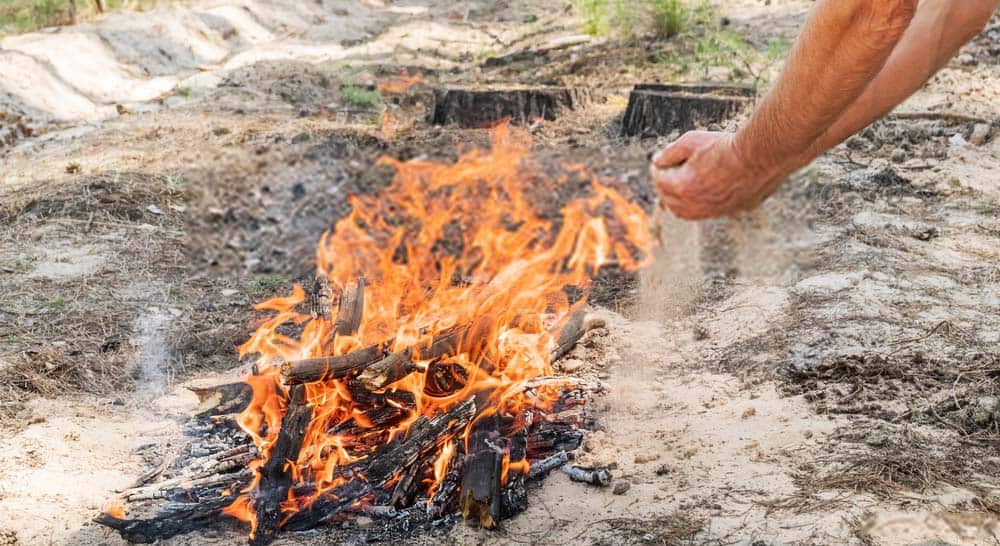
- Start putting out a fire early – Being able to fully extinguish a fire, even using water, can take much longer than you think. If you are camping, then set out a time you will be going to bed. About 20 minutes before bedtime is the time you want to start putting out a fire.
- Don’t pour water on – It’s tempting just to throw a bucket of water onto a fire to extinguish it, but this isn’t the best way to put it out. For safety, there should be a bucket of water near your fire at all times anyway. When you want to put it out, this should be your go-to option. The reason you don’t want just to pour a bucket of water onto the fire is that you will fill the pit. Being on a campsite means other people will want to use that fire pit later. Or you may need it for the morning. So instead of pouring water onto the fire, sprinkle it on instead. You should only use enough water to put out the embers.
- Stir your embers – while sprinkling the water over the fire, start to stir the embers with a shovel or a stick. This helps you to get all of the ashes wet. Listen out for a hissing noise or look for steam. Once these have stopped, you know the fire will nearly be extinguished.
- Try touching the ashes – Don’t rub your hands through the fire’s remains, though! The last thing you need is a third-degree burn from a scorching hot ember. Instead, you use the back of your hand and put it close to the ashes. If you can still feel the heat from the fire, it’s still considered too hot to leave alone. Continue adding in water and stir. When you can’t feel any heat from it anymore, you are safe to leave the fire.
- Clean up the ashes – Be a courteous camper. You wouldn’t want to clean up after anyone else, so don’t leave your ashes for the next person. If you’re not on a campsite and have made a fire bed for yourself, you should return the land to the same condition you found it in. All you need to do is get a bag and scoop the ashes into it. You can then dispose of them around the area or in a designated bin.
- Patch up the ground – Part of making a fire bed is digging up the dirt that makes it. You should keep this dirt on the side and replace all of it when you’re getting ready to leave a site.
- Avoid using dirt or sand – Many people advise using sand or dirt when extinguishing a fire. However, this solution can be riddled with issues. This is because the sand and dirt actually help insulate the fire and the embers. These embers or hot coals then get uncovered later on and can result in wildfires being caused.
- Never put trash in the fire that can’t be burnt – It’s very tempting to throw your can or plastic packaging into the fire to dispose of it. You should never, ever try to burn any trash in the fire that won’t be entirely consumed and turned into ash. Things like foil, plastic, and cans won’t ignite and will leave behind a mess for someone else to pick up. If there is anything left over that hasn’t been consumed by the flames when you leave the fire bed, then collect the remains for proper disposal. This could be taking it home with you or leaving it in a nearby bin.
